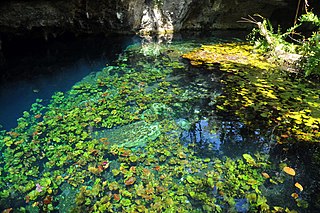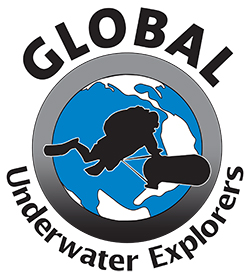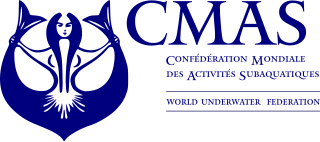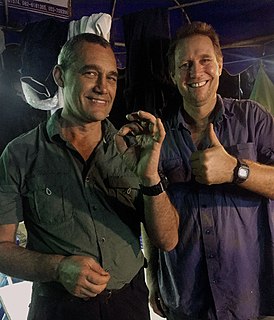
Technical diving is scuba diving that exceeds the agency-specified limits of recreational diving for non-professional purposes. Technical diving may expose the diver to hazards beyond those normally associated with recreational diving, and to a greater risk of serious injury or death. The risk may be reduced by appropriate skills, knowledge and experience, and by using suitable equipment and procedures. The skills may be developed through appropriate specialised training and experience. The equipment often involves breathing gases other than air or standard nitrox mixtures, and multiple gas sources.

Cave diving is underwater diving in water-filled caves. It may be done as an extreme sport, a way of exploring flooded caves for scientific investigation, or for the search for and recovery of divers lost as a result of one of these activities. The equipment used varies depending on the circumstances, and ranges from breath hold to surface supplied, but almost all cave diving is done using scuba equipment, often in specialised configurations with redundancies such as sidemount or backmounted twinset. Recreational cave diving is generally considered to be a type of technical diving due to the lack of a free surface during large parts of the dive, and often involves planned decompression stops.
Sheck Exley was an American cave diver. He is widely regarded as one of the pioneers of cave diving, and he wrote two major books on the subject: Basic Cave Diving: A Blueprint for Survival and Caverns Measureless to Man. On February 6, 1974, Exley became the first chairman of the Cave Diving Section of the National Speleological Society. During his career, he established many of the basic safety procedures used in cave and overhead diving today. Exley was also a pioneer of extreme deep scuba diving.

A cenote is a natural pit, or sinkhole, resulting from the collapse of limestone bedrock that exposes groundwater. The regional term is specifically associated with the Yucatán Peninsula of Mexico, where cenotes were commonly used for water supplies by the ancient Maya, and occasionally for sacrificial offerings. The term derives from a word used by the lowland Yucatec Maya—tsʼonot—to refer to any location with accessible groundwater.

Sistema Sac Actun is an underwater cave system situated along the Caribbean coast of the Yucatán Peninsula with passages to the north and west of the city of Tulum. Discovery of a connection to the Sistema Dos Ojos in 2008 made it the longest known underwater cave system.

Global Underwater Explorers (GUE) is a scuba diving organization that provides education within recreational, technical, and cave diving. It is a nonprofit membership organization based in High Springs, Florida, United States.
Tom Mount is a technical diver and cave diver. In 1991 Tom Mount joined Dick Rutkowski in the new organisation formed by Rutkowski, IANTD, dedicated to teaching Nitrox to recreational divers. In 1992 Mount was named president and chief executive officer of IANTD, a position that he held until 2005. Mount was also one of the pioneers in relation to diver training and development of dive tables in relation to the use of trimix as a breathing gas for diving. At the time, and for many years subsequently, IANTD was the only technical diver training organization in the world. Mount remains a member of the board of directors of the IANTD.

Confédération Mondiale des Activités Subaquatiques (CMAS) is an international federation that represents underwater activities in underwater sport and underwater sciences, and oversees an international system of recreational snorkel and scuba diver training and recognition. It is also known by its English name, the World Underwater Federation, and its Spanish name, Confederación Mundial De Actividades Subacuáticas. Its foundation in Monaco during January 1959 makes it one of the world's oldest underwater diving organisations.
David Apperley is an Australian technical diver and cave explorer. Apperley holds instructor levels in cave diving, Deep Mixed Gas Diving and Deep Closed Circuit Rebreather Diving and was the expedition co-ordinator for the Pearse Resurgence Project 1996–2003. He was the project leader on the Royal Mail Ship Niagara 2003 Survey Project, which involved the organization and planning of putting some of the world's most experienced divers onto the 130-metre-deep Niagara wreck site, off the North Island of New Zealand.
Samir Alhafith is an Australian technical diver, cave explorer and underwater filmmaker. He is the founder and team leader of the Sydney Project - an association of technical divers involved in researching and discovering important historical wrecks in depths between 75 and 135 metres on the south coast New South Wales.
The Cave Divers Association of Australia (CDAA) is a cave diving organisation which was formed in September 1973 to represent the interests of recreational scuba divers who dive in water‐filled caves and sinkholes principally in the Lower South East of South Australia (SA) and secondly in other parts of Australia. Its formation occurred after a series of diving fatalities in waterfilled caves and sinkholes in the Mount Gambier region between 1969 and 1973 and in parallel to a South Australian Government inquiry into these deaths. The CDAA's major achievement has been the dramatic reduction of fatalities via the introduction of a site rating scheme and an associated testing system which was brought in during the mid-1970s. While its major area of operation is in the Limestone Coast region of SA, it administers and supports cave diving activity in other parts of Australia including the Nullarbor Plain and Wellington, New South Wales.
Jarrod Michael Jablonski is a pioneering technical diver and record setting cave diver. Jablonski is one of the main architects behind the 'Doing It Right' system of diving.
The Fédération Française d'Études et de Sports Sous-Marins (FFESSM) is a French sports federation specialized in recreational and competition underwater sports, like scuba diving and freediving. It is the main diver training organization in France.

Agnes Milowka was an Australian technical diver, underwater photographer, author, maritime archaeologist and cave explorer. She gained international recognition for penetrating deeper than previous explorers into cave systems across Australia and Florida, and as a public speaker and author on the subjects of diving and maritime archaeology. She died aged 29 while diving in a confined space.

Craig Challen, is an Australian technical diver and cave explorer. He was the recipient of the Oztek 2009 Diver of the Year award for his services to caving, and was joint winner of the 2019 Australian of the Year.

Little Blue Lake is a water-filled doline in the Australian state of South Australia located in the state's south-east in the locality of Mount Schank about 20 kilometres (12 mi) south of the municipal seat of Mount Gambier. It is notable locally as a swimming hole and nationally as a cave diving site. It is managed by the District Council of Grant and has been developed as a recreational and tourism venue.

Jill Heinerth is a Canadian cave diver, underwater explorer, writer, photographer and film-maker. She has made TV series for PBS, National Geographic Channel and the BBC, consulted on movies for directors including James Cameron, written several books and produced documentaries including We Are Water and Ben's Vortex, about the disappearance of Ben McDaniel.

Richard "Harry" Harris,, is an Australian anaesthetist and cave diver who played a crucial role in the Tham Luang cave rescue. He and Craig Challen were jointly awarded 2019 Australian of the Year as a result of that rescue.
The Kilsby sinkhole is a sinkhole in Mount Gambier, South Australia. Since the late 1960s, the naturally occurring karst cenote has been used for recreational diving as well as civilian and police dive training.









